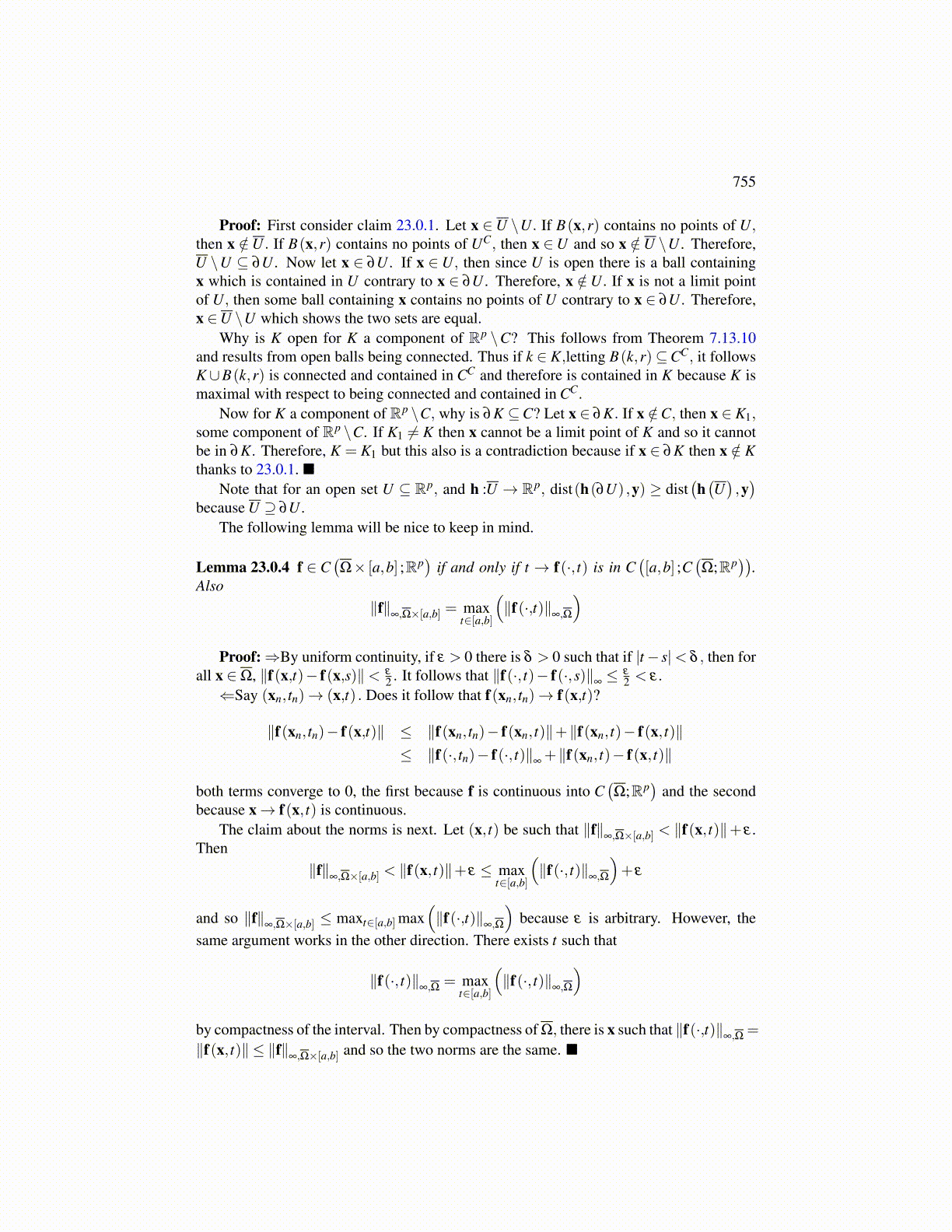
755
Proof: First consider claim 23.0.1. Let x ∈U \U. If B(x,r) contains no points of U,then x /∈U . If B(x,r) contains no points of UC, then x ∈U and so x /∈U \U . Therefore,U \U ⊆ ∂U . Now let x ∈ ∂U . If x ∈U, then since U is open there is a ball containingx which is contained in U contrary to x ∈ ∂U . Therefore, x /∈U. If x is not a limit pointof U, then some ball containing x contains no points of U contrary to x ∈ ∂U . Therefore,x ∈U \U which shows the two sets are equal.
Why is K open for K a component of Rp \C? This follows from Theorem 7.13.10and results from open balls being connected. Thus if k ∈ K,letting B(k,r)⊆CC, it followsK ∪B(k,r) is connected and contained in CC and therefore is contained in K because K ismaximal with respect to being connected and contained in CC.
Now for K a component of Rp \C, why is ∂K ⊆C? Let x ∈ ∂K. If x /∈C, then x ∈ K1,some component of Rp \C. If K1 ̸= K then x cannot be a limit point of K and so it cannotbe in ∂K. Therefore, K = K1 but this also is a contradiction because if x ∈ ∂K then x /∈ Kthanks to 23.0.1.
Note that for an open set U ⊆ Rp, and h :U → Rp, dist(h(∂U) ,y) ≥ dist(h(U),y)
because U ⊇ ∂U .The following lemma will be nice to keep in mind.
Lemma 23.0.4 f ∈ C(Ω× [a,b] ;Rp
)if and only if t → f(·, t) is in C
([a,b] ;C
(Ω;Rp
)).
Also∥f∥
∞,Ω×[a,b] = maxt∈[a,b]
(∥f(·,t)∥
∞,Ω
)Proof:⇒By uniform continuity, if ε > 0 there is δ > 0 such that if |t− s|< δ , then for
all x ∈Ω, ∥f(x,t)− f(x,s)∥< ε
2 . It follows that ∥f(·, t)− f(·,s)∥∞≤ ε
2 < ε .⇐Say (xn, tn)→ (x,t) . Does it follow that f(xn, tn)→ f(x,t)?
∥f(xn, tn)− f(x,t)∥ ≤ ∥f(xn, tn)− f(xn, t)∥+∥f(xn, t)− f(x, t)∥≤ ∥f(·, tn)− f(·, t)∥
∞+∥f(xn, t)− f(x, t)∥
both terms converge to 0, the first because f is continuous into C(Ω;Rp
)and the second
because x→ f(x, t) is continuous.The claim about the norms is next. Let (x, t) be such that ∥f∥
∞,Ω×[a,b] < ∥f(x, t)∥+ ε .Then
∥f∥∞,Ω×[a,b] < ∥f(x, t)∥+ ε ≤ max
t∈[a,b]
(∥f(·, t)∥
∞,Ω
)+ ε
and so ∥f∥∞,Ω×[a,b] ≤ maxt∈[a,b] max
(∥f(·,t)∥
∞,Ω
)because ε is arbitrary. However, the
same argument works in the other direction. There exists t such that
∥f(·, t)∥∞,Ω = max
t∈[a,b]
(∥f(·, t)∥
∞,Ω
)by compactness of the interval. Then by compactness of Ω, there is x such that
∥f(·,t)∥∞,Ω = ∥f(x, t)∥ ≤ ∥f∥
∞,Ω×[a,b]
and so the two norms are the same.